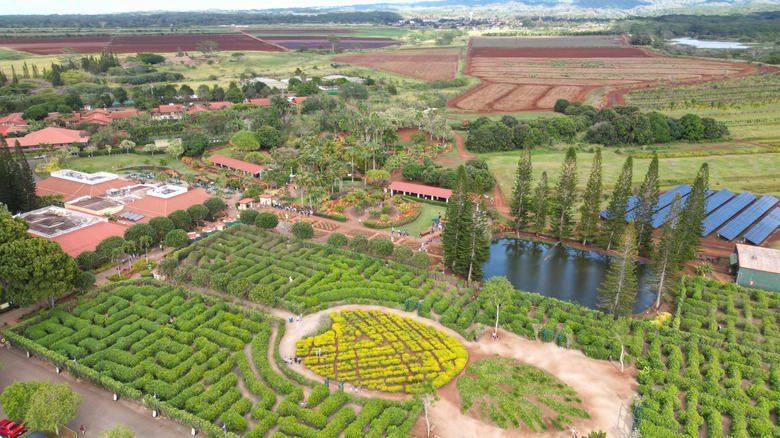Hawaii's Wildly Popular Dole Plantation Is A Tourist Trap That Isn't Worth Your Time While In Oahu
There are some tourist traps to avoid on your trip to Hawaii, and one of those is the Dole Plantation, which is all about pineapples. It's an admittedly impressive and popular site with the world's largest plant maze, and, in large part because of Dole, pineapples have become virtually synonymous with Hawaii despite not being a native plant to the islands. The Dole Plantation is a stop on many Oahu island tours that take you from Waikiki up to the North Shore, one of the most beautiful stretches of beach, then into the central part of the island where you can find Dole Plantation, and back to Honolulu.
Over a million people visit Dole Plantation every year, according to their website, but some people don't think it it worth it. There are better places to have similar experiences on the island. Plus, it's worth knowing a bit about the complicated history that Dole has played in Hawaii, which could give you another reason to skip it.
Some people on Tripadvisor noted how expensive everything was, from the price of the pineapples to the various attractions, and they felt that the entire visit was all about the Dole Plantation trying to get people to spend more money. Others noted how crowded it could get. One person sums it up on Tripadvisor as, "It's like someone built a large, completely unnecessary gift shop and then decided they needed an actual 'attraction' to go with it."
There are better options for train rides and botanical gardens on Oahu than the Dole Plantation
One Redditor chimes in on the topic of the Dole Plantation, saying, "The best thing they have imo is the Dole Whip, but you can get that elsewhere on Oahu. The only way I'd recommend it is for kids, as kids like the train, but I hear the lines get long."
As for the Pineapple Express train, which costs $15 for adults and $12.85 for kids at the time of this writing, the lines potentially being long isn't the only issue that people have with it. Another person on Reddit wrote, "That has to be the slowest train known to man. The worst part was that it's just an out and back so you see the exact same things on the return trip." As an alternative, you can try the train ride at the Hawaiian Railway Society. Located on Oahu's South Shore, you can take a two-hour ride along the coast in a historic train.
If you want to check out Hawaii's local plants, head to the Wahiawa Botanical Garden. Dating back to the 1930s, it features 27 acres of gardens within the island's tropical landscape. For even more vibrant flora on Oahu, the Lyon Arboretum at the University of Hawaii is another fantastic spot with miles of hiking trails and thousands of different plants and flowers. If you still want to learn more about agriculture in Hawaii, Turtle Bay Resort has the Kuilima Farm Tour. The 45-minute tour will give you insight into sustainable farming practices at the site and give you a taste of some of the produce in the gardens.
The Dole family played a controversial part of Hawaiian colonial history
The history of the Dole family in Hawaii is a complicated mix of both political and economic colonization. In the early 1900s, James Dole established his pineapple farm on Oahu, where the Dole Plantation is today. Several years before, in 1893, James's cousin, Sanford B. Dole, played a large part in the ousting of Queen Lili'uokalani, the last Hawaiian monarch.
James was able to develop a way to can pineapple to transport it to the mainland, which was a game changer for the industry, and he later bought the entire island of Lanai, west of Maui, to make into the world's largest pineapple plantation. The plantation's popularity continues to impact the local community, with one Redditor saying, "As a native Hawaiian, I've found it strange how much my town is represented through pineapples despite their connection to colonialism, labor abuse, and the eventual overthrow of our nation."
If your interest in the Dole Plantation is a historical one, the Bishop Museum in Honolulu is a better alternative. There is a wealth of exhibits on Hawaii's history, including the impacts of pineapple on Hawaiian culture. With crowds, high prices, and a controversial role in Hawaiian history, Dole Plantation just might not be worth it. There are plenty of other amazing experiences that you can only have on Oahu, so maybe skip the Dole Plantation on your next trip.


